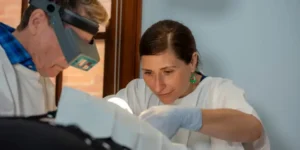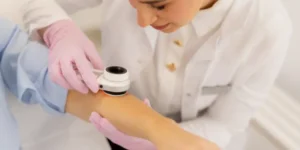Essential Melanoma Checks: Skin Cancer Screening and Skin Cancer Clinic Guide
Concerned about unusual spots or moles on your skin? Melanoma is a serious form of skin cancer that progresses quickly if not detected early. Regular melanoma checks and skin assessments are crucial in identifying issues promptly and can potentially save lives.
Stay protected—discover how to examine and take care of your skin in this guide!
Key Takeaways
- Early detection of melanoma can save lives. About 90% of cases are treatable with surgery if identified early.
- Skin cancer checks should be conducted every three months at home and annually with professionals. High-risk individuals may require more frequent screenings.
- Use the ABCDE guide to recognise warning signs: Asymmetry, Border irregularities, Colour changes, Diameter over 6mm, and Changing moles.
- Professional skin checks by GPs or dermatologists provide greater accuracy than self-checks using advanced tools such as dermatoscopes or digital monitoring systems.
- Clinics like The Skin Cancer Hub in Brisbane provide comprehensive care—from detection to treatment—without requiring a referral for booking appointments.
Importance of Regular Skin Cancer Screenings
 Early detection saves lives. Approximately 90% of melanomas can be managed with surgery if identified promptly. Routine skin cancer screenings assist in identifying concerns before they escalate.
Early detection saves lives. Approximately 90% of melanomas can be managed with surgery if identified promptly. Routine skin cancer screenings assist in identifying concerns before they escalate.
Overlooked symptoms might result in deformities or require more extensive treatment. Regular examinations improve the likelihood of detecting skin cancers early, simplifying treatment.
Many forms are treatable when discovered in time.
Signs and Symptoms of Melanoma
Melanoma can show up as a new spot or a change in an existing one. It might also appear on body areas not exposed to the sun.
- Spots that bleed, ooze, or seem unusual compared to others should be evaluated.
- Variations in size, shape, or colour of a mole may indicate melanoma warning signs.
- Skin growths or lesions that cause irritation or discomfort can be a concern.
- Uncommon skin spots with uneven edges could suggest issues.
- Atypical moles with multiple colours are another key indicator.
- Dark patches that extend into surrounding skin require attention.
- Blemishes that don’t heal adequately may highlight skin abnormalities.
- Colour changes like darkened pigmentation can signal melanoma concerns.
Recognising basal cell carcinoma (BCC) is another significant aspect when assessing skin cancer symptoms…
Identifying Basal Cell Carcinoma (BCC)
Basal Cell Carcinoma (BCC) is the most common type of skin cancer. It often appears as red, pale, or shiny lumps. Some may notice dry, scaly patches on sun-exposed areas like the face, neck, and arms.
BCC grows slowly and rarely spreads but can cause damage if left untreated.
Early detection is key. Around 90% of cases are treatable with surgery when found in time. Treatments could also include radiation therapy or Mohs surgery for precise removal. Spotting changes early helps manage risks better—read further to learn about Squamous Cell Carcinoma (SCC).
Recognising Squamous Cell Carcinoma (SCC)
Squamous Cell Carcinoma (SCC) often appears as thick, red, scaly patches. These spots may bleed or crust over time. SCC develops slowly, usually over months on areas exposed to the sun like the face, neck, arms or hands.
It’s more common in people aged 50 and older.
Long-term sun damage and UV exposure increase risk. Early detection is key to prevent it from becoming malignant. A dermatologist can confirm with a biopsy if a lesion seems suspicious.
Treatment might include surgery or radiation therapy depending on severity.
ABCDE Melanoma Detection Guide
Melanoma can be dangerous if not identified in its early stages. The ABCDE guide assists in examining skin spots for potential warning signs.
- Asymmetry – One side of the mole differs from the other. This may indicate abnormal growth.
- Border – Observe edges that are uneven, blurry, or notched instead of smooth and consistent.
- Colour – Pay attention to moles with varied colours such as brown, black, red, white, or blue shades combined in one spot.
- Diameter – Spots larger than 6mm (approximately the size of a pencil eraser) could require closer evaluation by a dermatologist.
- Evolving – Monitor changes in shape, size, colour, or symptoms such as itching and bleeding over time.
Next: Understand the significance of professional skin checks in detecting melanoma early.
Professional Skin Checks
Spotting melanoma early is crucial. Professional skin checks can help detect concerns missed at home. GPs often perform these screenings and may treat some cancers or refer patients to specialists if needed.
Skin cancer clinics focus on advanced care, using high-tech tools for detailed skin lesion evaluations. Dermatologists, who need GP referrals, offer expert assessments for complex cases.
Clinics like the Skin Cancer Hub provide comprehensive melanoma screening services customised to patient requirements.
Comprehensive Skin Cancer Care
Regular skin checks can help catch cancer early—when it’s easiest to treat. A professional screening provides a thorough look at spots you might miss during self-checks.
How often to schedule skin checks
Skin checks should be performed every three months. This aligns with seasonal changes and assists in identifying early signs of skin cancer. Capture clear images of your moles to monitor any changes in size, shape, or colour.
Consult a doctor if you observe new moles after the age of 25. Moles that appear unusual in appearance also require prompt examination. Detecting skin cancer early can prevent its progression and save lives.
What to expect during a professional screening
Doctors or specialists will examine your skin closely. They will check moles, spots, and unusual areas. You may need to remove certain clothing for a full-body check.
Tools like dermatoscopes help inspect small details. If something looks suspicious, they might suggest a biopsy for testing. Clinics like The Skin Cancer Hub use advanced technology to assist in accurate detection—leading into how often checks are necessary.
Skin Check Apps and Technology
Apps now help monitor skin changes. Mole tracking apps let users take photos of moles and compare them over time. These apps can spot visible changes but cannot replace professional diagnosis.
Dermatology tools like digital skin analysis and total body photography offer detailed tracking. Early detection technology improves monitoring for new or changing spots. Remote skin checks are also becoming more common with mobile skin monitoring systems.
Skin Cancer Clinic Guide
Selecting a reputable skin cancer clinic can significantly impact detection and care. Take into account the clinic’s location, the range of services provided, and the expertise of the health professionals when scheduling your appointment.
Choosing the right clinic
Choose a clinic with advanced equipment, such as dermatoscopes and digital monitoring systems. These support accurate skin cancer detection. Clinics managed by GPs and connected to dermatology specialists provide enhanced care options.
Certain clinics allow appointments without needing referrals—making services easily accessible. Seek facilities that provide detection, skin biopsy, and treatment all in one place.
Simplifying follow-ups is essential.
Booking appointments and follow-ups
Booking appointments and follow-ups for skin checks is simple but essential. Regular screenings can catch problems early, ensuring better outcomes.
- No referral is needed to book at Skin Cancer Hub in Woolloongabba. This makes it convenient and hassle-free.
- Schedule your professional skin checks every three months to align with seasonal changes.
- During a check-up, bring photos of moles for comparison and tracking changes over time.
- Follow-ups allow dermatologists to monitor developing issues effectively and discuss treatment plans if necessary.
- Set reminders for follow-up consultations to avoid missing future appointments.
Professional skin checks provide accurate results that at-home methods cannot match…
Skin Checks in Brisbane City
The Skin Cancer Hub in Brisbane provides professional skin cancer checks and care. Situated at 61 Ipswich Rd, Woolloongabba, it is equipped with cutting-edge facilities. You can book an appointment without needing a referral.
Detecting skin cancer early is crucial. Routine screenings aid in identifying melanoma and other types of skin cancer promptly. Consult experienced specialists for comprehensive examinations in Brisbane City.
For more information, see Skin Checks in Brisbane City
Comparison Table: At-Home Checks vs. Professional Screenings
At-home skin checks and professional screenings offer different benefits. Use both to enhance melanoma detection.
| Aspect | At-Home Checks | Professional Screenings |
|---|---|---|
| Who Conducts It | You, in a well-lit room with a mirror. | GPs, dermatologists, or skin cancer specialists. |
| Tools Needed | Full-length mirror, hairdryer, smartphone for photos. | Dermatoscopes, digital monitoring, total body photography. |
| Frequency | Every 3 months for best results. | Annually; more often if high risk. |
| Coverage | Limited—some areas like scalp or back may be hard to inspect alone. | Comprehensive—includes hard-to-see areas. |
| Detection Accuracy | Depends on your experience and vigilance. | More accurate—specialists trained in skin cancer detection. |
| Cost | Free, only requires basic tools. | May involve clinic fees or specialist charges. |
| Purpose | Monitor changes in moles over time. | Identify, diagnose, and treat skin abnormalities. |
Let’s explore what to expect during a professional skin check.
Checking Your Skin: Why a Skin Check Can Reveal an Early Sign of Trouble and Changes in Colour
Taking a skin check seriously is the best way to detect an early sign of skin abnormalities. Because some lesions may appear harmless initially, checking your skin often allows you to catch issues before they escalate. This post is worth reading if you want to monitor your skin effectively, reduce the risk of melanoma, and understand when it’s important to get professional help.
What Is a Mole?
A mole can be brown or black, pink, or even vary in colour or size. While most are harmless, a mole that looks different or changes over time could signal a deeper problem. If you notice a new or evolving mole, keep in mind risk factors like frequent burn or a compromised immune system.
Why Is Diagnosis Crucial?
Accurate diagnosis is the key to saving lives. If a suspicious growth is found early, it’s more likely to cure successfully. Dermatologists specialise in dermoscopy and other medical tests to confirm whether you have a severe condition. They can also advise on further steps if needed.
Are You at Risk of Melanoma?
Melanoma may be more common in Australian climates that get much uv radiation. This cancer can begin as a mole that may appear on arms and legs, the sole of your foot, or other areas. Nodular melanoma is an example that can grow quickly and even lead to a sore spot. If you notice anything alarming, seek medical advice as soon as possible.
Does Surgery Help?
If your risk of melanoma is high, surgery might be recommended. Minor procedures can remove suspicious lesions, often preventing more harmful developments. Medical professionals treat such growths carefully, ensuring minimal damage to healthy tissue.
What About Treatment of Melanoma?
Treatment of melanoma can involve surgical removal, topical options, and other techniques. Early intervention often results in a positive outcome. Whether it’s nodular melanoma or another type, immediate attention boosts the chances of a full cure.
Why a Thorough Approach Matters
A thorough routine includes scanning each freckle, paying attention to any elevation, and checking for lack symmetry. This process may also include asking a family member or friend to check areas you can’t see, like behind your ear or along a finger. Remember, melanoma can occur on parts of the body that get minimal sun exposure.
How to Get Reliable Advice?
Experts can take a sample if they see a mole or freckle that raises suspicion. They’ll also consider your melanin level and whether your skin is dark skin or lighter. If you’re unsure, see your doctor or seek medical advice quickly.
Should You Worry About Burn History?
Repeated burn injuries may compromise your immune system, increasing your vulnerability. Always stay alert to any new spot or a freckle that changes shape.
Comparison Table: Common Forms of Skin Cancer
| Type | Often Found | Likely Growth Rate |
|---|---|---|
| Melanoma | Arms and legs or trunk | Rapid |
| Basal Cell | Exposed Areas | Slow |
| Squamous Cell | Pink, scaly patches | Moderate |
Why Check Thoroughly?
Constantly checking your skin is the best way to spot new sign of damage. If you notice any changes, seek medical assistance right away.
Key Takeaways:
- Early diagnosis boosts your chances of a cure.
- A mole that looks different could signal melanoma.
- Request advice if you have dark skin or repeated burn.
- A thorough approach includes scanning freckle patterns for any nodular melanoma.
- Seek medical help as soon as possible if you spot something suspicious.
Conclusion
Early skin checks save lives. Identifying changes promptly leads to improved outcomes and minimal treatment. Use tools such as the ABCDE guide to monitor warning signs. Consult professionals, like Skin Cancer Hub, for comprehensive care and guidance.
Acting now safeguards your health in the future.
FAQs
1. What is a skin cancer screening?
A skin cancer screening is a check by a doctor or specialist to spot signs of melanoma or other types of skin cancer early.
2. Why are regular melanoma checks important?
Regular checks help find changes in moles or spots that could be dangerous, allowing treatment before the cancer spreads.
3. How do I choose the right skin cancer clinic?
Look for clinics with trained specialists, advanced tools for detection, and good reviews from patients.
4. What should I expect during a visit to a skin cancer clinic?
The doctor will examine your skin closely, sometimes using special equipment like dermatoscopes, and may recommend further tests if needed.





